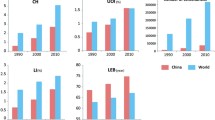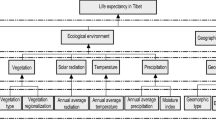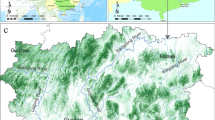Abstract
The spatial heterogeneity and influence factors of public lifespan have been reported worldwide at the national level or typical longevous areas. However, few sub-national studies considering the living environment and socio-economic level together have been explored in the imbalanced developed region with a huge population base and deteriorated air quality. In this paper, spatial heterogeneity of lifespan integrating environment and socio-economic influence factors was investigated in the Beijing-Tianjin-Hebei (BTH) region of China using geographically weighted regression (GWR). Five indicators were constructed to determine the lifespan based on the three national censuses (1990–2010) in the BTH region. The results showed that the areas with higher CH (centenarians per 100,000 inhabitants) and centenarity index (CI) exhibited changing distribution in the BTH region, whereas those with lower CH and CI and extreme value of the ultra-octogenarian index (UOI) and LI (> 90/ > 65) maintained a relatively stable feature through time. But as lifespan indicators increase overall, the differences between the counties/districts widen. Furthermore, remarkable spatial heterogeneity was detected for the associations between the significant environmental and socio-economic variables and lifespan indicators. Although the natural geographic condition (altitude) still exhibited a negative influence on the longevity of the population, the socio-economic factors (GDPpc and income level) showed a more dominant influence on the extension of the elderly and longevity population. Correspondingly, the widened unbalance of population lifespan (UOI, LI, CH) was considered closely related to the socio-economic polarization, and the adverse effects of air pollution on life expectancy at birth (LEB) have also emerged. To further improve the overall lifespan level and narrow the lifespan gap in the BTH region, future work on cleaner air and more balanced development is still needed.
Graphical abstract









Similar content being viewed by others
Data availability
The datasets used and/or analyzed during the current study are available from the corresponding author on reasonable request.
Abbreviations
- UOI:
-
Ultra-octogenarian index
- LI:
-
Longevity index, > 90/ > 65
- CH:
-
Centenarians per 100,000 inhabitants
- CI:
-
Centenarity index
- LEB:
-
Life expectancy at birth
- DEM:
-
Digital evaluation model or the altitude
- AP:
-
Average annual precipitation
- AT:
-
Average annual temperature
- GDPpc :
-
Per capita GDP
- NIRRpc :
-
Per capita net income of rural residents
- WIURave :
-
Average wage income of urban residents
- HEP%:
-
Proportion of higher educational population
- AQI:
-
Air quality index
- PM2.5:
-
Particulate matter with a diameter of < 2.5 µm
- PM10:
-
Particulate matter with a diameter of < 10 µm
- LISA:
-
Local indicators of spatial association
- BTH:
-
Beijing-Tianjin-Hebei region
- GWR:
-
Geographically weighted regression
- SMLR:
-
Stepwise multiple linear regression
- VIF:
-
Variance inflation factors
- AICc:
-
Akaike information criterion
References
Anderson RN (1999): Method for constructing complete annual US life tables, 129. National Center for Health Statistics
Azin AL, Zeldi IP, Smirnov AV, Shagibalov RZ (2001) Aging and longevity as indicators of ecological health of the environment. Russ J Ecol 32:216–219
Bennett JE, Tamura-Wicks H, Parks RM, Burnett RT, Pope CA III, Bechle MJ, Marshall JD, Danaei G, Ezzati M (2019) Particulate matter air pollution and national and county life expectancy loss in the USA: a spatiotemporal analysis. PLOS Medicine 16:e1002856
Bossuyt N, Gadeyne S, Deboosere P, Van Oyen H (2004) Socio-economic inequalities in health expectancy in Belgium. Public Health 118:3–10
Brunsdon C, Fotheringham AS, Charlton ME (1996) Geographically weighted regression: a method for exploring spatial nonstationarity. Geogr Anal 28:281–298
Cao J, Yang C, Li J, Chen R, Chen B, Gu D, Kan H (2011) Association between long-term exposure to outdoor air pollution and mortality in China: a cohort study. J Hazard Mater 186:1594–1600
Chatterjee S, Price B (1995) Praxis der Regressionsanalyse. R.Oldenbourg Verlag, München Wien
Chen Y, Ebenstein A, Greenstone M, Li H (2013) Evidence on the impact of sustained exposure to air pollution on life expectancy from China’s Huai River policy. Proc Natl Acad Sci 110:12936–12941
Cheng QD (1998) The climate has an effect on health. Liberty Army Health 5:18
Christensen K, Vaupel JW (1996) Determinants of longevity: genetic, environmental and medical factors. J Intern Med 240:333–341
Cicconetti P, Tafaro L, Tedeschi G, Tombolillo MT, Ciotti V, Troisi G, Marigliano V (2002) Lifestyle and cardiovascular aging in centenarians. Arch Gerontol Geriatr 35:93–98
Conti B (2008) Considerations on temperature, longevity and aging. Cell Mol Life Sci 65:1626–1630
Cossman JS, Cossman RE, James WL, Campbell CR, Blanchard TC, Cosby AG (2007) Persistent clusters of mortality in the United States. Am J Public Health 97:2148–2150
Croix Ddl (2008) Adult longevity and economic take-off: from Malthus to Ben-Porath. Institutional and Social Dynamics of Growth and Distribution. https://doi.org/10.4337/9781781000595.00013
Dong Z, Li L, Lei Y, Wu S, Yan D, Chen H (2021) The economic loss of public health from PM2.5 pollution in the Fenwei Plain. Environ Sci Pollut R 28:2415–2425
DRSES (2011) 2010 China rural statistical yearbook, Department of Rural Socio-Economic Survey. State Statistical Bureau of China, Beijing
Einspruch EL (2004) Next steps with SPSS. Sage Publications, London
Finch CE (2010) Evolution in health and medicine Sackler colloquium: evolution of the human lifespan and diseases of aging: roles of infection, inflammation, and nutrition. Proc Natl Acad Sci 107:1718–1724
Fotheringham AS, Brunsdon C, Charlton M (2003) Geographically weighted regression: the analysis of spatially varying relationships. John Wiley & Sons
Franceschi C, Bonafè M (2003) Centenarians as a model for healthy aging. Biochem Soc Trans 31:457–461
Fritz M, Berger PD (2015) Chapter 10 - can you relate in multiple ways? Multiple linear regression and stepwise regression. In: Fritz M, Berger PD (eds) Improving the User Experience Through Practical Data Analytics. Morgan Kaufmann, Boston, pp 239–269
Gu H, Cao Y, Elahi E, Jha SK (2019) Human health damages related to air pollution in China. Environ Sci Pollut R 26:13115–13125
Hitt R, Young-Xu Y, Silver M, Perls T (1999) Centenarians: the older you get, the healthier you have been. The Lancet 354:652
Hurvich CM, Simonoff JS, Tsai C-L (1998) Smoothing parameter selection in nonparametric regression using an improved Akaike information criterion. Journal of the Royal Statistical Society: Series B (statistical Methodology) 60:271–293
Jiang G, He X, Ma W, Wang M (2015) Evolution of spatial pattern and its division of rural settlement based on spatial autocorrelation. Journal of Agro Engineering 31:265–273
Kawata Y (2009) Socioeconomic factors influencing longevity in Japan. Atl Econ J 37:113–114
Kennedy BK (2008) The genetics of ageing: insight from genome-wide approaches in invertebrate model organisms. J Intern Med 263:142–152
Law J, Richmond RL, Kay-Lambkin F (2014) The contribution of personality to longevity: findings from the Australian centenarian study. Arch Gerontol Geriatr 59:528–535
Le Bras A (2020) A systems biology approach to understand the effects of diet on lifespan. Lab Anim 49:251–251
Lelieveld J, Pozzer A, Pöschl U, Fnais M, Haines A, Münzel T (2020) Loss of life expectancy from air pollution compared to other risk factors: a worldwide perspective. Cardiovasc Res 116:1910–1917
Li RB, Tan JA, Wang WY, Yang H (2000) The yearly change and regional difference of population life-span in China. Hum Geogr 15:1–6
Lim YH, Bell ML, Kan H, Honda Y, Guo YLL, Kim H (2015) Economic status and temperature-related mortality in Asia. Int J Biometeorol 59:1405–1412
Liu Y, Luo K, Lin X, Gao X, Ni R, Wang S, Tian X (2014) Regional distribution of longevity population and chemical characteristics of natural water in Xinjiang. China Sci Total Environ 473–474:54–62
Liu Y, Wu J, Yu D (2017) Characterizing spatiotemporal patterns of air pollution in China: a multiscale landscape approach. Ecol Ind 76:344–356
Ljungquist B, Berg S, Lanke J, McClearn GE, Pedersen NL (1998) The effect of genetic factors for longevity: a comparison of identical and fraternal twins in the Swedish Twin Registry. The Journals of Gerontology: Series A 53:441–446
Lu J, Wang H, Pan Y (2004) Analysis of determinants of population longevity at county level in China. Population & Economics 5:13–18
Lu J, Wang H, Pan Y (2005) Analysis of environmental and socio-economic determinants affecting population longevity level at county level in China. Chinese Journal of Population, Resources and Environment 3:36–41
Lutz W (2007) Vienna yearbook of population research 2007. Vienna Yearbook of Population Research 2007(2007):379
Lv J, Wang W, Li Y (2011) Effects of environmental factors on the longevous people in China. Arch Gerontol Geriatr 53:200–205
Magnolfi SU, Petruzzi E, Pinzani P, Malentacchi F, Pazzagli M, Antonini FM (2007) Longevity index (LI%) and centenarity index (CI%): new indicators to evaluate the characteristics of aging process in the Italian population. Arch Gerontol Geriatr 44:271–276
Magnolfi SU, Noferi I, Petruzzi E, Pinzani P, Malentacchi F, Pazzagli M, Antonini FM, Marchionni N (2009) Centenarians in Tuscany: the role of the environmental factors. Arch Gerontol Geriatr 48:263–266
Matthews RJ, Jagger C, Hancock RM (2006) Does socio-economic advantage lead to a longer, healthier old age? Soc Sci Med 62:2489–2499
McMillen DP (2004) Geographically weighted regression: the analysis of spatially varying relationships. Oxford University Press
Moatt J, Savola E, Regan J, Nussey D, Walling C (2020): Lifespan extension via dietary restriction: time to reconsider the evolutionary mechanisms? BioEssays 42
Morand OF (2004) Economic growth, longevity and the epidemiological transition. The European Journal of Health Economics, Formerly: HEPAC 5:166–174
Murabito JM, Yuan R, Lunetta KL (2012) The search for longevity and healthy aging genes: insights from epidemiological studies and samples of long-lived individuals. The Journals of Gerontology: Series A 67A:470–479
PCOSC (2002) Tabulation on the 2000 population census of the People’s Republic of China. 7503738723, Population Census Office under the State Council, Department of Population Statistics. State Statistical Bureau of China, Beijing
PCOSC (2012) Tabulation on the 2010 population census of the People’s Republic of China. 7503738723, Population Census Office under the State Council, Department of Population Statistics. State Statistical Bureau of China, Beijing
Pope CA, Ezzati M, Dockery DW (2009) Fine-particulate air pollution and life expectancy in the United States. N Engl J Med 360:376–386
Pope CA, Ezzati M, Dockery DW (2013) Fine particulate air pollution and life expectancies in the United States: the role of influential observations. J Air Waste Manag Assoc 63:129–132
Poulain M, Pes GM, Grasland C, Carru C, Ferrucci L, Baggio G, Franceschi C, Deiana L (2004) Identification of a geographic area characterized by extreme longevity in the Sardinia island: the AKEA study. Exp Gerontol 39:1423–1429
Preston SH (1975) The changing relation between mortality and level of economic development. Popul Stud 29:231–248
Pu H, Luo K, Zhang S, Du Y, Zhao C (2018) Relationship between lifespan indicators and elemental background values: a case study in Guangdong Province. China Sci Total Environ 624:1658–1668
Qin J Yu G Xia T Li Y Liang X Wei P Long B Lei M Wei X Tang X Zhang Z (2017): Spatio-temporal variation of longevity clusters and the influence of social development level on lifespan in a Chinese longevous area (1982–2010). International Journal of Environmental Research and Public Health 14
QSW (2019) Coordinated development of Beijing-Tianjin-Hebei: new stage, new mission and new task. QiuShiNet, http://www.qstheory.cn/llqikan/2019-06/24/c_1124664185.htm. Accessed 17 Mar 2021
Schabenberger O, Gotway CA (2017) Statistical methods for spatial data analysis. CRC Press
Schendera CF (2014) Regressionsanalyse mit SPSS. De Gruyter Oldenbourg, München
SCPRC (2019) Notice of the State Council on the conduct of the seventh national census. State Council of the People's Republic of China, http://www.gov.cn/zhengce/content/2019-11/08/content_5450146.htm. Accessed 17 Mar 2021
Spiegel MR, Stephens LJ (2018) Schaum’s Outline of Statistics. McGraw-Hill Education, New York
SSBC (2018) China Statistical Yearbook. State Statistical Bureau of China, Beijing
Sharma MJ, Yu SJ (2015) Stepwise regression data envelopment analysis for variable reduction. Appl Math Comput 253:126–134
Song X, Chen G, Zheng X (2010) Chinese life expectancy and policy implications. Procedia Soc Behav Sci 2:7550–7555
Song W, Li Y, Hao Z, Li H, Wang W (2016) Public health in China: an environmental and socio-economic perspective. Atmos Environ 129:9–17
Taghipour Javi S, Malekmohammadi B, Mokhtari H (2014) Application of geographically weighted regression model to analysis of spatiotemporal varying relationships between groundwater quantity and land use changes (case study: Khanmirza Plain, Iran). Environ Monit Assess 186:3123–3138
Tan JA, Li RB, Wang WY (1990) The progress in medical geography of china and its prospect. Acta Geogr Sin 45:187–201
Tanaka S (2015) Environmental regulations on air pollution in China and their impact on infant mortality. J Health Econ 42:90–103
Wang S, Ren Z (2019) Spatial variations and macroeconomic determinants of life expectancy and mortality rate in China: a county-level study based on spatial analysis models. Int J Public Health 64:773–783
Wang S, Wu J (2020) Spatial heterogeneity of the associations of economic and health care factors with infant mortality in China using geographically weighted regression and spatial clustering. Social Science & Medicine 263:113287
Wang C, Zhou X, Chen R, Duan X, Kuang X, Kan H (2013) Estimation of the effects of ambient air pollution on life expectancy of urban residents in China. Atmos Environ 80:347–351
Wang L, Wei B, Li Y, Li H, Zhang F, Rosenberg M, Yang L, Huang J, Krafft T, Wang W (2014) A study of air pollutants influencing life expectancy and longevity from spatial perspective in China. Sci Total Environ 487:57–64
Wang S, Luo K, Liu Y (2015a) Spatio-temporal distribution of human lifespan in China. Sci Rep 5:13844
Wang S, Luo K, Liu Y, Zhang S, Lin X, Ni R, Tian X, Gao X (2015b) Economic level and human longevity: spatial and temporal variations and correlation analysis of per capita GDP and longevity indicators in China. Arch Gerontol Geriatr 61:93–102
Wang H, Zhang Y, Zhao H, Lu X, Zhang Y, Zhu W, Nielsen CP, Li X, Zhang Q, Bi J, McElroy MB (2017) Trade-driven relocation of air pollution and health impacts in China. Nat Commun 8:738
Wilmoth JR, Lundström H (1996) Extreme longevity in five countries. Eur J Popul 12:63–93
Xia Y, Zhong M (2016) Relationship between EKC hypothesis and the decoupling of environmental pollution from economic development: based on China prefecture-level cities’ decoupling partition. China Popul Resour Environ 26:8–16
Yu D (2007) Modeling owner-occupied single-family house values in the city of Milwaukee: a geographically weighted regression approach. Giscience & Remote Sensing 44:267–282
Zallaghi E, Goudarzi G, Sabzalipour S, Zarasvandi A (2021) Effects of long-term exposure to PM2.5 on years of life lost and expected life remaining in Ahvaz city, Iran (2008–2017). Environ Sci Pollut R 28:280–286
Zheng X, Song X, Chen G, You Y, Ren Q, Liu J, Zhang L, Tan L, Wei J, Chen Q (2011) Health inequalities during 20 years of rapid economic development in China (1980–2000): a mortality analysis. Biomed Environ Sci 24:329–334
Zhou L, Wu J, Jia R, Liang N, Zhang F, Ni Y, Liu M (2016) Investigation of temporal-spatial characteristics and underlying risk factors of PM2.5 pollution in Beijing-Tianjin-Hebei area. Res Environ Sci 29:483–493
Zhou T, Jiang G, Zhang R, Zheng Q, Ma W, Zhao Q, Li Y (2018) Addressing the rural in situ urbanization (RISU) in the Beijing–Tianjin–Hebei region: spatio-temporal pattern and driving mechanism. Cities 75:59–71
Zou B, You J, Lin Y, Duan X, Zhao X, Fang X, Campen MJ, Li S (2019) Air pollution intervention and life-saving effect in China. Environ Int 125:529–541
Acknowledgements
The authors express their gratitude for data support from the Hebei Provincial Bureau of Statistics and data calculation assistance from Dr. Xiaofeng Zhao.
Funding
This work was supported by the National Key Research and Development Program of China (Grant No. 2018YFC1800106) and the Chinese Academy of Sciences (CAS) Scholarship.
National Key Research and Development Program of China,2018YFC1800106,Mei Lei,Chinese Academy of Sciences (CAS) Scholarship
Author information
Authors and Affiliations
Contributions
Project administration: Mei Lei. Funding acquisition: Mei Lei. Conceptualization: Shaobin Wang. Methodology: Shaobin Wang. Formal analysis: Changhe Wei. Investigation: Changhe Wei. Data curation: Changhe Wei, Shaobin Wang. Writing—original draft: Changhe Wei. Visualization: Changhe Wei. Writing—review and editing: Mei Lei, Shaobin Wang. Supervision: Mei Lei, Shaobin Wang.
Corresponding authors
Ethics declarations
Ethics approval
Not applicable.
Consent to participate
I am free to contact any of the people involved in the research to seek further clarification and information.
Consent for publication
Not applicable.
Competing interests
The authors declare no competing interests.
Additional information
Responsible Editor: Philippe Garrigues
Publisher's note
Springer Nature remains neutral with regard to jurisdictional claims in published maps and institutional affiliations.
Supplementary Information
Below is the link to the electronic supplementary material.
Rights and permissions
About this article
Cite this article
Wei, C., Lei, M. & Wang, S. Spatial heterogeneity of human lifespan in relation to living environment and socio-economic polarization: a case study in the Beijing-Tianjin-Hebei region, China. Environ Sci Pollut Res 29, 40567–40584 (2022). https://doi.org/10.1007/s11356-022-18702-4
Received:
Accepted:
Published:
Issue Date:
DOI: https://doi.org/10.1007/s11356-022-18702-4




